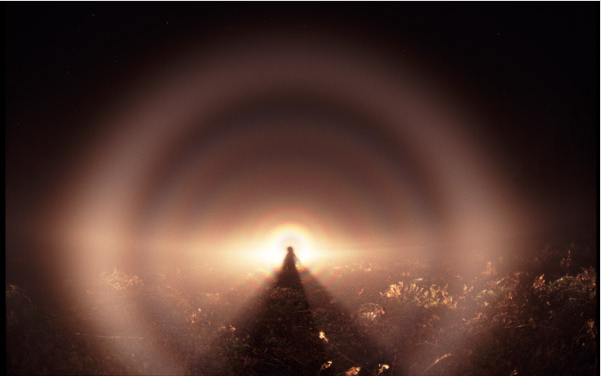Fogbow
The Enigmatic Fogbow: A Spectacle of Atmospheric Optics
Have you ever witnessed a foggy morning transform into a mesmerizing display of ethereal light? If so, you may have been lucky enough to catch a glimpse of a phenomenon known as a fogbow. Similar to a rainbow, but with a ghostly appearance, fogbows captivate observers with their subtle hues and elusive beauty. In this article, we will delve into the captivating world of fogbows, exploring their formation, unique characteristics, and the science behind their enigmatic presence in our atmosphere.
What is a Fogbow?
A fogbow, also referred to as a white rainbow or cloudbow, is a meteorological phenomenon that occurs when light is refracted and reflected by tiny water droplets suspended in fog. Unlike rainbows, which are formed by raindrops, fogbows are created by the diffraction of light within these minuscule water droplets. The result is a pale, almost colorless arc that appears against a backdrop of mist or fog.
Formation and Characteristics
Fogbows share many similarities with rainbows, but they possess distinct characteristics that set them apart. Here are some key features of these elusive atmospheric wonders:
-
Color Palette: While rainbows exhibit a vibrant spectrum of colors, fogbows tend to be predominantly white or pale in appearance. This lack of color is due to the smaller size of the water droplets involved in fog formation.
-
Ghostly Appearance: Fogbows often appear faint and ethereal, blending seamlessly into the misty surroundings. This ghostly quality adds to their allure and makes them particularly captivating to behold.
-
Lack of Secondary Bow: Unlike rainbows, which often have a secondary bow caused by double reflection within raindrops, fogbows typically lack this secondary feature. This absence further contributes to their subtle and delicate nature.
-
Supernumerary Bands: In certain conditions, fogbows may exhibit additional, fainter bands of light known as supernumerary bands. These bands appear on the inner edge of the main arc and can create a mesmerizing visual effect.
The Science Behind Fogbows
To understand the science behind fogbows, we must explore the principles of light refraction and diffraction. When sunlight encounters tiny water droplets in fog, it is refracted as it enters and exits the droplets. The refracted light then undergoes diffraction, which causes it to spread out and form an arc. The specific angle at which this diffraction occurs determines the size and shape of the fogbow.
The size of the water droplets plays a crucial role in the formation of fogbows. Unlike rainbows, where larger raindrops disperse light into its various colors, fog droplets are much smaller and produce a diffraction pattern that results in a predominantly white arc. When these droplets are exceptionally uniform in size, as is the case in certain conditions, fogbows can display supernumerary bands, adding an extra touch of enchantment to the spectacle.
Where and When to Spot Fogbows
Fogbows are most commonly observed in regions with frequent foggy or misty conditions. Coastal areas, valleys, and forests are often prime locations for experiencing these atmospheric wonders. Furthermore, fogbows tend to be more prevalent during the early morning or late afternoon when the sun is low on the horizon, casting its rays through the fog at an optimal angle for diffraction.
Photographing Fogbows
Capturing the delicate beauty of a fogbow through photography can be a rewarding challenge. To enhance your chances of capturing this elusive phenomenon, consider the following tips:
-
Positioning: Position yourself with the sun behind you and the fogbow in front. This will ensure that the sunlight refracts and diffuses through the fog droplets, creating the fogbow.
-
Exposure Settings: Experiment with exposure settings to achieve the best results. Since fogbows are fainter than rainbows, you may need to adjust your camera settings to capture their subtle hues.
-
Composition: Incorporate the surrounding environment, such as misty landscapes or silhouettes, to add depth and context to your fogbow photographs.
The Fascination Continues
While fogbows may not possess the vibrant colors of rainbows, their delicate and ethereal appearance holds a unique fascination for those lucky enough to witness them. Whether you stumble upon a fogbow during an early morning walk or purposely seek out these atmospheric spectacles, their transient and elusive nature makes each sighting a truly magical experience. So, keep your eyes peeled on misty mornings and embrace the wonder of the enigmatic fogbow.

Car headlight fogbow, glory and Brocken spectre. We are looking away from the headlight and outwards along its beam. At centre, a glory scatters the light brightly backwards. The photographer's Brocken spectre points to the glory centre where the camera's shadow lies. The glory's rings merge into multiple fogbow supernumeraries. Fogbows and glories rarely have this finesse. These fog droplets evidently had a very uniform size indeed. Photographed in Finland during autumn by Marko Riikonen (site) and Jarmo Moilanen. ©Marko Riikonen, shown with permission.
Note: this article has been automatically converted from the old site and may not appear as intended. You can find the original article here.
Reference Atmospheric Optics
If you use any of the definitions, information, or data presented on Atmospheric Optics, please copy the link or reference below to properly credit us as the reference source. Thank you!
-
<a href="https://atoptics.co.uk/blog/fogbow-2/">Fogbow</a>
-
"Fogbow". Atmospheric Optics. Accessed on April 20, 2024. https://atoptics.co.uk/blog/fogbow-2/.
-
"Fogbow". Atmospheric Optics, https://atoptics.co.uk/blog/fogbow-2/. Accessed 20 April, 2024
-
Fogbow. Atmospheric Optics. Retrieved from https://atoptics.co.uk/blog/fogbow-2/.